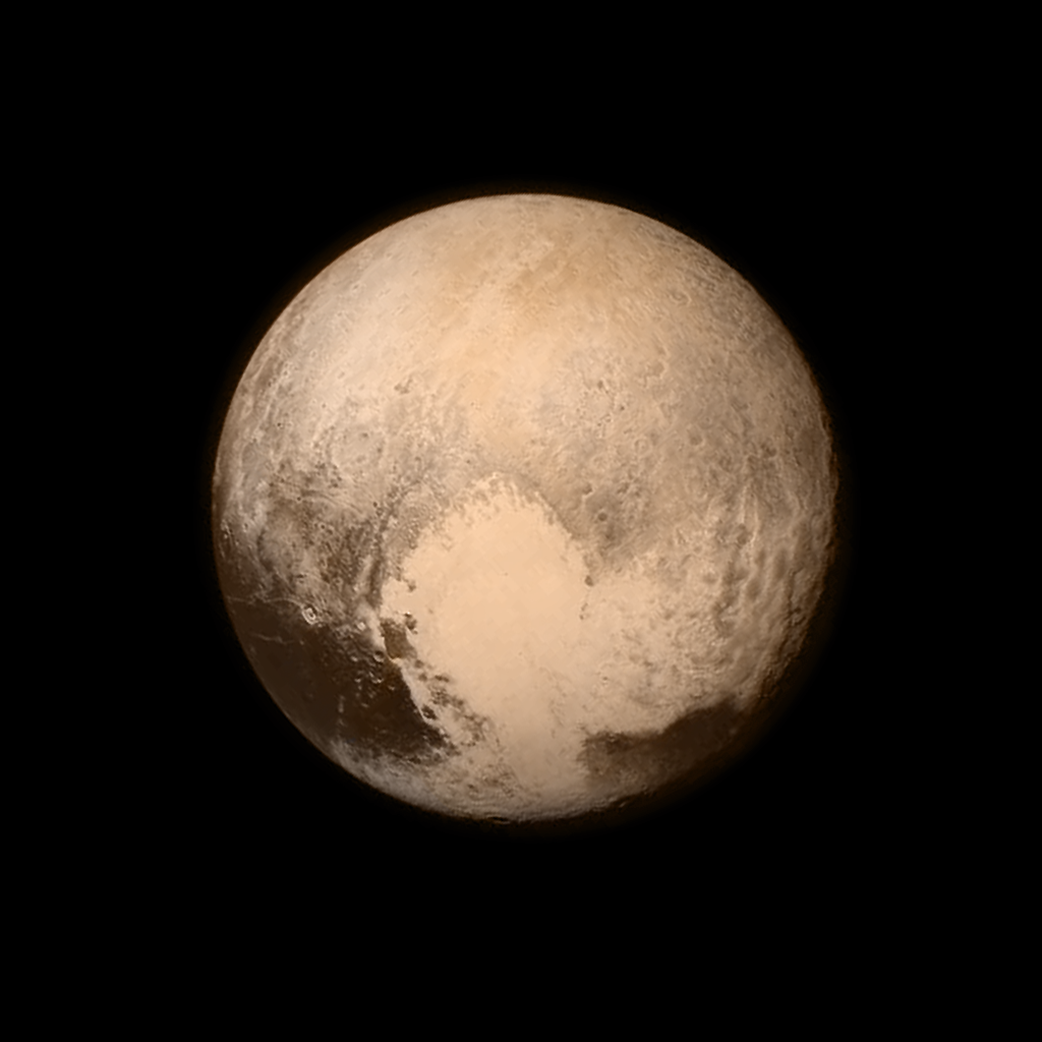
Pluto nearly fills the frame in this image from the Long Range Reconnaissance Imager aboard NASA’s New Horizons spacecraft on July 13, 2015 when the spacecraft was 476,000 miles (768,000 kilometers) from the surface. This is the last and most detailed image sent to Earth before the spacecraft’s closest approach to Pluto on July 14: NASA
By Glynn Wilson –
After a decade-long journey through the solar system, NASA’s New Horizons spacecraft made its closest approach to Pluto on Tuesday, making it the first-ever space mission to explore a world so far from Earth.
The craft passed 7,750 miles above the surface of the dwarf planet, roughly the distance from New York to Mumbai, India.
“I’m delighted at this latest accomplishment by NASA, another first that demonstrates once again how the United States leads the world in space,” said John Holdren, assistant to the President for Science and Technology and director of the White House Office of Science and Technology Policy. “New Horizons is the latest in a long line of scientific accomplishments at NASA, including multiple missions orbiting and exploring the surface of Mars in advance of human visits still to come.”
Other NASA missions are planned, including the Kepler mission to identify Earth-like planets around stars other than our own. The DSCOVR satellite will soon be beaming back images of the whole Earth in near real-time from a vantage point a million miles away. New Horizons will complete its flyby of Pluto and continue deeper into the Kuiper Belt.
“The exploration of Pluto and its moons by New Horizons represents the capstone event to 50 years of planetary exploration by NASA and the United States,” NASA Administrator Charles Bolden said. “Once again we have achieved a historic first. The United States is the first nation to reach Pluto, and with this mission has completed the initial survey of our solar system, a remarkable accomplishment that no other nation can match.”
As planned, the spacecraft is in data-gathering mode and not in contact with flight controllers at the Johns Hopkins University Applied Physical Laboratory in Laurel, Maryland. Scientists are waiting to find out whether New Horizons “phones home,” transmitting to Earth a series of status updates that indicate the spacecraft survived the flyby and is in good health. The “call” is expected shortly after 9 p.m. Tuesday night.
The Pluto story began only a generation ago when young Clyde Tombaugh was tasked to look for Planet X, theorized to exist beyond the orbit of Neptune. He discovered a faint point of light that we now see as a complex and fascinating world.
“Pluto was discovered just 85 years ago by a farmer’s son from Kansas, inspired by a visionary from Boston, using a telescope in Flagstaff, Arizona,” John Grunsfeld, associate administrator for NASA’s Science Mission Directorate in Washington, said. “Today, science takes a great leap observing the Pluto system up close and flying into a new frontier that will help us better understand the origins of the solar system.”
New Horizons’ flyby of the dwarf planet and its five known moons is providing an up-close introduction to the solar system’s Kuiper Belt, an outer region populated by icy objects ranging in size from boulders to dwarf planets. Kuiper Belt objects, such as Pluto, preserve evidence about the early formation of the solar system.
New Horizons principal investigator Alan Stern of the Southwest Research Institute in Boulder, Colorado, says the mission now is writing the textbook on Pluto.
“The New Horizons team is proud to have accomplished the first exploration of the Pluto system,” Stern said. “This mission has inspired people across the world with the excitement of exploration and what humankind can achieve.”
New Horizons’ almost 10-year, three-billion-mile journey to closest approach at Pluto took about one minute less than predicted when the craft was launched in January 2006. The spacecraft threaded the needle through a 36-by-57 mile (60 by 90 kilometers) window in space — the equivalent of a commercial airliner arriving no more off target than the width of a tennis ball.
Because New Horizons is the fastest spacecraft ever launched, hurtling through the Pluto system at more than 30,000 mph, a collision with a particle as small as a grain of rice could incapacitate the spacecraft. Once it reestablishes contact Tuesday night, it will take 16 months for New Horizons to send its 10 year cache of data back to Earth.
New Horizons is the latest in a long line of scientific accomplishments at NASA, including multiple rovers exploring the surface of Mars, the Cassini spacecraft that has revolutionized our understanding of Saturn and the Hubble Space Telescope, which recently celebrated its 25th anniversary. All of this scientific research and discovery is helping to inform the agency’s plan to send American astronauts to Mars in the 2030’s.
“After nearly 15 years of planning, building, and flying the New Horizons spacecraft across the solar system, we’ve reached our goal,” project manager Glen Fountain said. “The bounty of what we’ve collected is about to unfold.”
The research group in Maryland designed, built and operates the New Horizons spacecraft and manages the mission for NASA’s Science Mission Directorate. The research group in Boulder leads the mission, science team, payload operations and encounter science planning.
New Horizons is part of NASA’s New Frontiers Program, managed by the agency’s Marshall Space Flight Center in Huntsville, Alabama.
Follow the New Horizons mission on Twitter and use the hashtag #PlutoFlyby to join the conversation. Live updates also will be available on the mission Facebook page.
For more information on the New Horizons mission, including fact sheets, schedules, video and images, visit these links.














Very exciting indeed. I can’t help crowing that my brother (from good ole Alabama) has just joined the APL team at John Hopkins and, to celebrate this enormous space adventure, my sister, author T.K. Thorne is sharing a scifi short story she wrote circa 2006 when New Horizons launched. Always been one of my favorites. http://tks-tales.com/2015/07/12/a-passion-for-pluto/